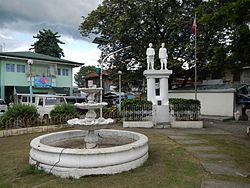Country Philippines Founded 1727 Time zone PST (UTC+8) Local time Tuesday 4:17 AM Province Cavite | District 7th District of Cavite Barangays Area 164.6 km² Area code 46 | |
 | ||
Region CALABARZON (Region IV-A) Weather 24°C, Wind NW at 5 km/h, 82% Humidity University Polytechnic University of the Philippines Maragondon | ||
Hillside artistry in maragondon cavite
The Municipality of Maragondon (Filipino: Bayan ng Maragondon) is a third class municipality in the province of Cavite, Philippines. Maragondon is 54 kilometres (34 mi) south-west from Manila. According to the 2015 census, it has a population of 37,720 people.
Contents
- Hillside artistry in maragondon cavite
- Map of Maragondon Cavite Philippines
- Barangays
- History
- Demographics
- List of former Town Heads
- Capitanes Municipal
- Landmarks
- References
Map of Maragondon, Cavite, Philippines
The name of the town is often confused by immigrants and visitors from Cebu, mistakenly calling it as Marigondon, which is a barangay in Lapu-Lapu City.
Barangays
Maragondon is politically subdivided into 27 barangays.
History
The name Maragondon was derived from Tagalog word madagundong or maugong, meaning much sound. Actually the sounds comes from a noisy river called Kay Albaran in the barrio of Capantayan. This area was the first townsite selected, but because the river frequently overflowed and flooded the place, the town was later relocated to its present site. The word madagundong not being pleasant to the ear, the people had it changed to marigundong in honor of the town' s patron saint, Nuestra Senora Maria Asuncion (Our Lady of The Assumption).
Soon after the establishment of the American regime, Lope K. Santos, an authority on Tagalog language and member of a geographic committee created to "investigate and revise" the names of Philippine towns and provinces, recommended the change of Marigundong to "Maragondon" definitely more pleasing to the ear, the present name of the town
Incidentally, Maragondon has three foundation dates; namely, 1. ) 1611 when the Franciscan Fathers from Silang established their first visita or chapel; 2.) 1690, the Fundacion Ecclesiastica or founding of the regular parish by the Jesuits, dedicating it to Our Lady of the Assumption; 3.) 1727, the Fundacion Civil, when the original barrio of Maragondon was separated from Silang during the administration of the Recollects and converted into an independent municipality with Gregorio Silvestre as the first gobernadorcillo. Maragondon belonged to the corregimiento of Mariveles (now Bataan province) until 1754 when Spanish governor General Pedro Manuel de Arandia (1754 A- 1759) abolished the politico A- military administration and restored Maragondon Cavite Province.
In the second half of the 19th century the towns of Ternate, Magallanes, Bailen, Alfonso, and Naic were mere barrios of Maragondon. Ternate was separated from Maragondon on March 31, 1857, under an agreement signed by Tomas de Leon, Felix Nigosa, Pablo de Leon, Florencio Nino Franco and Juan Ramos in behalf of the people of Ternate.
Furthermore, Bailen (now Gen. Aguinaldo) and Alfonso seceded from Maragondon in 1858. Magallanes followed suit on July 15, 1879 under an agreement signed by Crisostomo Riel presenting Maragondon, and by Isidro Bello and company representing Magallanes.
Maragondon played a significant role in the Philippine revolution. Although the town belonged to the jurisdiction at the Magdiwang Council, its brave sons like the three Riego de Dios brothers ( Emiliano, Vicente and Mariano), Esteban Infante, Crisostomo Riel, Vicente Somoza and Antero C. Reyes proved their unflinching loyalty to the Aguinaldo government.
All of them stuck to the revolution headed by Gen. Emilio Aguinaldo. Emiliano and Mariano Riego de Dios became top ranking generals; Vicente, a colonel, commanded the revolutionary troops as signed at Noveleta, the Magdiwang headquarters. Gen. Emiliano Riego de Dios was one of the three provincial governors of Cavite under the revolutionary government; and Mariano became the Taong Aguila (Eagle man) who saved Aguinaldo from certain death in the battle of Naic. Gen. Mariano Riego de Dios, Colonel Crisostomo Riel and Colonel Esteban Infante were members of the council of war that tried and convicted the Bonifacio brothers (Andres and Procopio) of sedition and treason against the duly established the revolutionary government of Aguinaldo.
The Bonifacio brothers were sentenced to death by the council of war owing to their supposed counter revolutionary activities. Mariano Riego de Dios and Esteban Infante believed that the sentence was quiet harsh and abstained from signing the death verdict. Aguinaldo agreed with them and ordered commutation of the sentence from death to banishment to the mountain of Pico de Loro in Maragondon. At the seniors general?, including Gen. Mariano Noriel, chairman of military court, and Gen. Pio del Pilar, to prevail upon Aguinaldo to withdraw the commutation. Bonifacio’s were executed in Mt. Nagpatong, not Mt. Buntis as erroneously stated in most history books on May 10, 1897.
Demographics
In the 2015 census, the population of Maragondon was 37,720 people, with a density of 230 inhabitants per square kilometre or 600 inhabitants per square mile.
List of former Town Heads
For more than three centuries officials of Maragondon have scrupulously kept a complete of its town heads from its establishment as a municipality to the present. The list follows:
Capitanes Municipal
- Emiliano Riego de Dios 1895–1896
- Primitivo Cuajunco 1897
- Luis Rillo 1899
